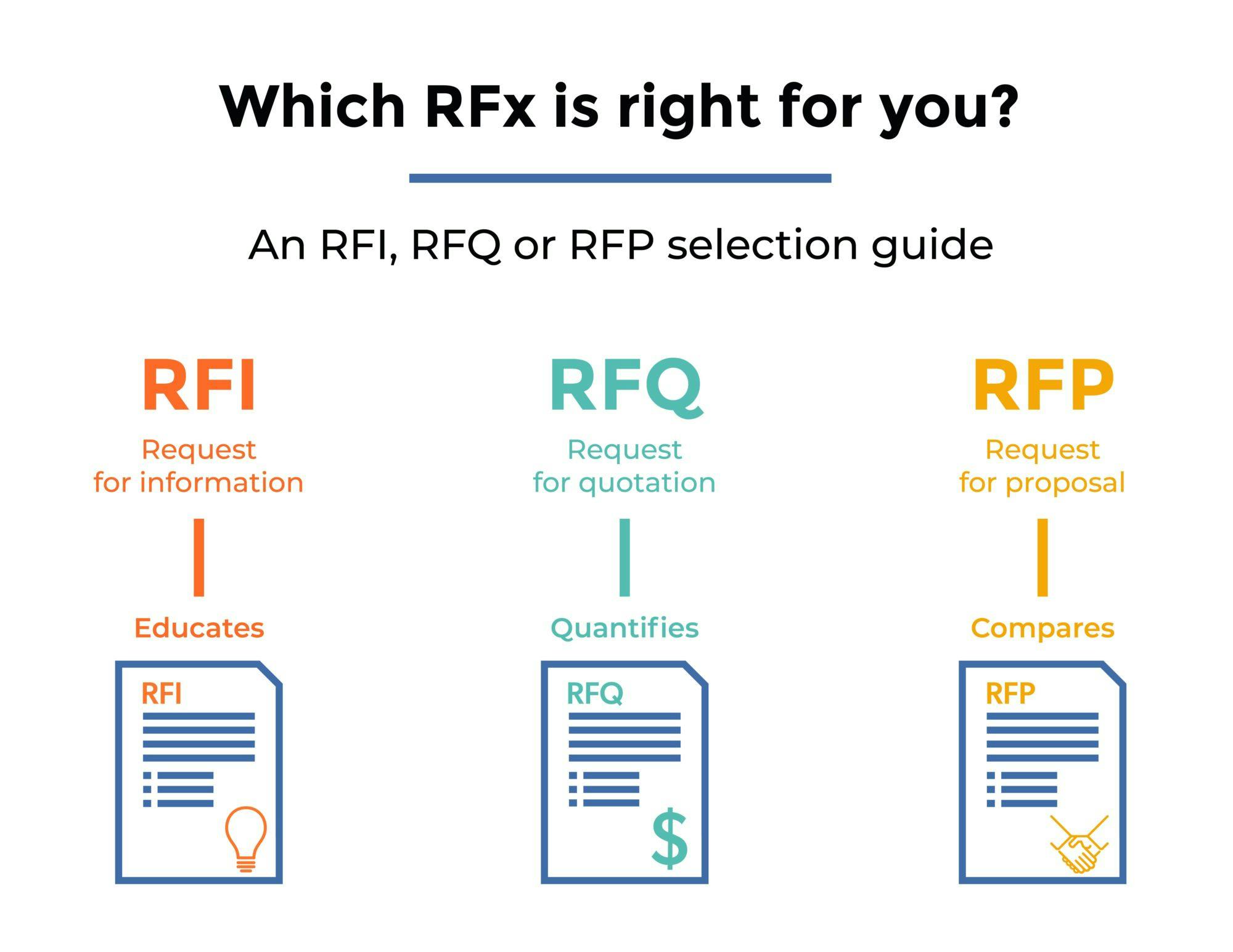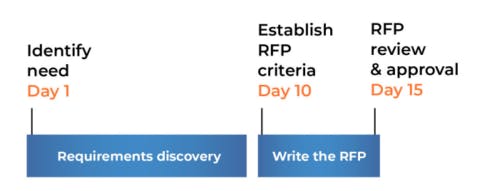RFP basics
To ensure we're all on the same page and you get the most out of this guide, we'll start with the basics. Here you'll find the answers to:
- What is an RFP?
- Who is involved in the RFP process?
- Why do organizations issue RFPs?
- And, when should you issue an RFP?
What is a request for proposal (RFP)?
An RFP is a formal, questionnaire-style document issued to prospective vendors from an organization that intends to buy a product or service. The RFP gathers vendor data in a standardized and organized format enabling faster, easier comparisons. And, what is the RFP process? The RFP process is the workflow and steps required to select the right vendor while minimizing cost and risk.
The process is designed to be an objective and systematic approach to sourcing and purchasing. Because of the detailed and thorough nature of the RFP, it can be used to more confidently select the best vendor for long-term partnerships. This holistic approach to procurement is also called strategic sourcing. Accordingly, RFPs have played a crucial role in helping almost every business achieve their goals.
Why do organizations issue RFPs?
Vendor partnerships can make or break your organization. Accordingly, RFPs help to ensure that vendor selection is data-based, strategic and thoughtful. The process yields short- and long-term benefits.
- Ensure data-based, strategic vendor selection. RFPs help organizations choose vendors based on thorough data, ensuring decisions are thoughtful and strategic for both short- and long-term success.
- Account for complex considerations. When making high-value purchases, organizations must consider multiple factors like vendor experience, financial health, and security practices. RFPs centralize this information, making it easier to compare vendors.
- Encourage competitive pricing. By fostering competition, RFPs encourage vendors to submit their best offers, helping organizations secure competitive pricing while choosing the right partner.
- Ensure a fair and unbiased process. RFPs provide a standardized approach to collecting data, ensuring objectivity and avoiding favoritism or bias. For government entities, this process may be required to ensure transparency.
- Reduce risk. The RFP process helps mitigate risk by scrutinizing vendors' sustainability practices, security policies, and regulatory compliance, highlighting any potential issues before a contract is signed.
When should you issue an RFP?
Because of the time required to create and manage them, RFPs aren't a fit for every purchase. Remember, the benefit of the RFP is to save money and protect your organization. So, if you have a small, one-time purchase, the risk is probably minimal and the time investment of an RFP may outweigh the potential benefit.
To help provide guidance, organizations commonly establish a cost threshold in their procurement policy. If the project budget meets or exceeds the set amount, an RFP must be issued. The threshold varies based on the size of the organization but typically falls somewhere between $5,000 and $250,000. In addition, RFPs are a good idea for strategic projects or purchases that have a large organizational impact.
Use an RFP if:
- Your project is strategic, high value or high impact
- You have specific questions for vendors
- You're ready to make a purchase
If this doesn't describe your project, you may need to use a different type of vendor information request. For example, consider using a request for information (RFI), request for quotation (RFQ), request for qualifications (RFQ) or request for offer (RFO). Explore these additional request management (RFX) processes here. Or click the infographic below to view a guide.
Who is involved in the RFP process?
To be successful, requests for proposals require tremendous coordination. Various stakeholders must work together to identify a need, gather information and explore solutions.
Defining and documenting key roles and responsibilities ensures your organization develops an effective RFP process.
Business stakeholders
RFPs often start with an individual, department or team that requests a purchase or solution. Often, input directly from these stakeholders guides the project. From defining the need to writing the RFP to scoring the results, having engaged stakeholders improves project outcomes. In addition, the business stakeholder may also create and manage the RFP.
Procurement professionals
As the architects and managers of the RFP process, procurement professionals are essential to success. They vet the request. Then they facilitate the creation, distribution and evaluation of RFPs. In addition, they work with vendors throughout the process to monitor progress, answer questions and provide feedback. Common titles of procurement professionals include procurement manager, strategic sourcing manager and other procurement roles.
Consultant
An organization that doesn't have the expertise or bandwidth to navigate the RFP process may hire a procurement consultant. They interview the client to understand needs and leverage their expertise to select qualified vendors, manage communication and assess results before making a recommendation.
Executives, CFOs and CPOs
For high-cost, strategic procurement projects, an executive, chief procurement officer or chief financial officer is usually tasked with providing final approval for the purchase. They will evaluate cost, projected return on investment and alignment with organizational goals.
Vendors
Organizations invited to respond to an RFP are called vendors or suppliers. They prepare a proposal that answers the RFP questions, highlights their differentiators and, ideally, persuades the buyer that they're the right choice for the project.

3 RFP process steps
RFPs are designed to provide a lot of crucial information in order to allow a business to make an informed and strategic decision. To achieve that goal, a substantial amount of preparation, research and skillful execution is required.
RFP process timeline overview
The typical RFP process timeline from start to finish ranges from 4 to 8 weeks, with many organizations completing RFPs in under a month by front-loading alignment and using digital tools.

While it may seem complicated, the RFP process is fairly straightforward when broken down into three core steps.
1. Creation
The first step of the process is RFP development. It includes planning, stakeholder interviews, research and writing. Perhaps the most important (and difficult) part of the process, the time you invest in this step pays off throughout the rest of the project. As you develop an RFP, remember that the more thoughtful and thorough you are now, the better your vendor responses will be later.
Start with spend analysis to identify sourcing potential and uncover categories where issuing an RFP can improve cost efficiency, supplier innovation, or compliance. Talk to internal stakeholders, assess the current supplier landscape, and test the market with exploratory conversations.

- What do you want to accomplish with your purchase?
- Requirements and scope – What elements are must-have items? Are there items that are just nice to have? Is there anything that is out of scope?
- Budget – What is your budget for the project?
- RFP timeline – When is your proposal deadline?
- Submission requirements – How should proposals be delivered, and how long should they be?
- Evaluation criteria – What parts of the project are the highest priority?
- RFP questions – What information and data will help you make your decision?
Write RFP questions
Every RFP has questions. While some have a dozen questions, others may have hundreds. To simplify evaluation, it is helpful to keep the number of RFP questions as low as possible. Not only do shorter RFPs make selecting the right vendor much more simple, it will also increase the on-time completion and prevent helpful vendors from declining to respond.
For essential requirements, phrasing questions in a yes or no format can help quickly eliminate unqualified or underqualified suppliers. On the other hand, if you're seeking a partner with a deep understanding of your industry and needs, open text answers can encourage suppliers to share their creativity and vision.
RFP issuers should ask questions about the vendor's experience in their industry. It's important to determine whether a vendor understands the business's challenges and can use their experience to be successful.
As you build RFPs, you may find it helpful to save them as templates. Remember, always follow RFP template best practices. Review your templates, customize and remove any unnecessary or irrelevant questions. RFP software makes this easy with dynamic templates broken down into sections.
Sample questions to ask in an RFP
There are dozens of questions you can ask in your RFP. In fact, here's a list of 101 of the most common and best RFP questions to consider. In addition, we've selected a few here to help inspire your next RFP.
Who are your competitors?
Asking this question can help issuers determine a vendor's integrity. It lets issuers know whether the vendors are honest about who their competitors are and why they lose to them. It can also help issuers determine if there are other options they should explore.
What is your implementation process like?
When purchasing software, setting it up correctly is crucial to maximizing its effectiveness. RFP issuers should determine how long the implementation process will take and how involved the vendor will be.
What kind of training do you offer?
The more complex the solution, the more important this question is. Certainly, if you don't understand how to use all the solution's features and functionality, you may miss out on key benefits. Issuers should inquire about the vendor's customer success team, scope of training vendors offer, as well as the available formats. For example, will support only be offered by phone or will there also be online self-service and email?
How do you handle customer support?
Almost all software users encounter an issue at some point in time. Issuers should determine how long vendors take to respond to customer support requests, as well as how they can submit those requests.
Do you offer a trial?
Free trials can give issuers a clear picture of what the vendor has to offer with no risk to their organization.
Can you provide references, reviews and case studies?
In the absence of a trial, there's no better way to determine the effectiveness of a solution than by learning about the experiences of those who already use it. Ask to talk directly to a current customer or request relevant case studies. If possible, request to speak to a current customer that has a similar business or use case.
2. Administration
The second step of the RFP process includes selecting vendors, issuing your RFP, answering questions, waiting for proposals and following up as the deadline approaches. Fortunately, this step requires slightly less effort than the other two.

Select vendors
Once you've written your RFP, it's time to select the vendors you want to invite to participate. Generally, you want to end up with three qualified vendors to choose from. With that in mind, use your market research to select a short list of about six vendors to invite to your RFP.
Issue the RFP
If you manage the RFP process using spreadsheets and Word you'll likely send your RFP invitation to vendors using email. As you can imagine, sending RFPs through email creates a lot of traffic in your inbox. Alternatively, if you use RFP management software, you'll simply send all your invitations in the system. RFP tools improve collaboration and cut the time required to issue an RFP by up to half.
Set realistic deadlines for vendor responses. Most vendors can respond within reasonable timeframes when given clear expectations and sufficient time to prepare quality proposals.
Respond to questions
It's common for vendors to have follow-up questions after reading your RFP. They may need clarification on an RFP requirement or want additional details about your specific needs.
When you receive these questions, gather them together. Answer each question in the list and send it back to all the vendors. This ensures that all participants have the same information and none have an advantage over the others. It's worth noting that this is another helpful function of RFP software. Rather than fielding questions via dozens of emails, use a request for proposal tool to keep your inbox clean.
Send final reminders
Ideally, you'll have lots of proposals before your deadline. If not, it's helpful to send a quick and gentle deadline reminder to vendors that haven't yet responded. Encourage them to participate and let them know you're excited to see their proposal. It's also helpful to attach the RFP and remind them of the anticipated date of the final decision.
3. Evaluation
The last step of the RFP process is to review the vendor proposals, compare them and select a winner. It's crucial to engage stakeholders in this process to provide their perspective and expertise.

Review responses
Before you begin scoring, gather your vendor proposals to review them for compliance to the submission and minimum requirements. Using the guidelines provided in your RFP, verify that vendors followed the submission instructions and responded to all required questions.
If you discover noncompliant proposals, you'll have to decide your next steps. You have two options. First, you can disqualify any vendor who did not meet the requirements. This is the simplest approach, but it may narrow your options too much. Second, you can contact vendors to request a correction or clarification. Allowing revisions increases the number of vendors to choose from. However, it will also delay the final selection timeline. Regardless, it's important to be consistent with your approach for all vendors to ensure fairness.
Score the proposals
Once you've isolated your selection to only qualified vendors, it's time to score your proposals. To begin, refresh your memory by reviewing the list of needs and wants. You may find it helpful to create a scoring rubric based on your RFP requirements to help guide the process.
Now, section by section, decide which stakeholders should score the proposals. For example, the data security and technical specifications sections should be reviewed by a stakeholder from IT because they have relevant experience and can provide valuable insights.
Certainly, you may review and score in a group setting or individually. If individual scores are provided, areas of disagreement can be identified and addressed if necessary. This improves buy-in from stakeholders and ensures that each perspective is accounted for.
Once the stakeholders score each question, average them. Next, total the overall score for the section. Then, use RFP weighted scoring to calculate final section scores and total scores for each vendor. Weighted scoring allows you to prioritize considerations, giving sections or individual questions that represent the areas of biggest concern more overall value.
While this is a very basic overview of RFP scoring, it's a complex topic that you could write a whole book about. And, we did.
If you'd like to explore RFP scoring approaches and best practices in more detail, check out this ebook: RFP scoring ebook: Best practices for vendor selection.
Compare your options
After scoring each proposal, compare vendors side by side to narrow the field. If you're using spreadsheets, you may find it helpful to create a single-page comparison, called a vendor comparison matrix, to review each vendor's section score and total score. If you use an RFP tool, this is done for you automatically.
Ideally, you have a high-scoring front runner that checks all your boxes and can move forward with them. However, if you have several options with similar scores, you may need to explore further.
Frequently asked questions
What are RFP process steps?
The RFP process consists of three main steps: Creation, Administration, and Evaluation. During Creation, you develop the RFP through planning, stakeholder interviews, research, and writing. Administration involves selecting vendors, issuing the RFP, answering questions, and following up. Evaluation includes reviewing vendor proposals, scoring them, and selecting the winner. The typical timeline ranges from 4 to 8 weeks from start to finish.
What does RFP process mean?
The RFP process is the workflow and steps required to select the right vendor while minimizing cost and risk. It's designed to be an objective and systematic approach
